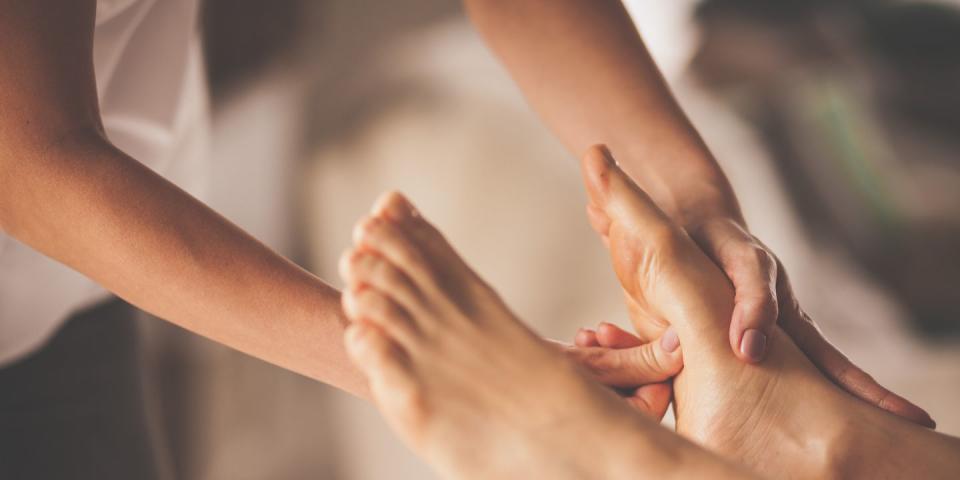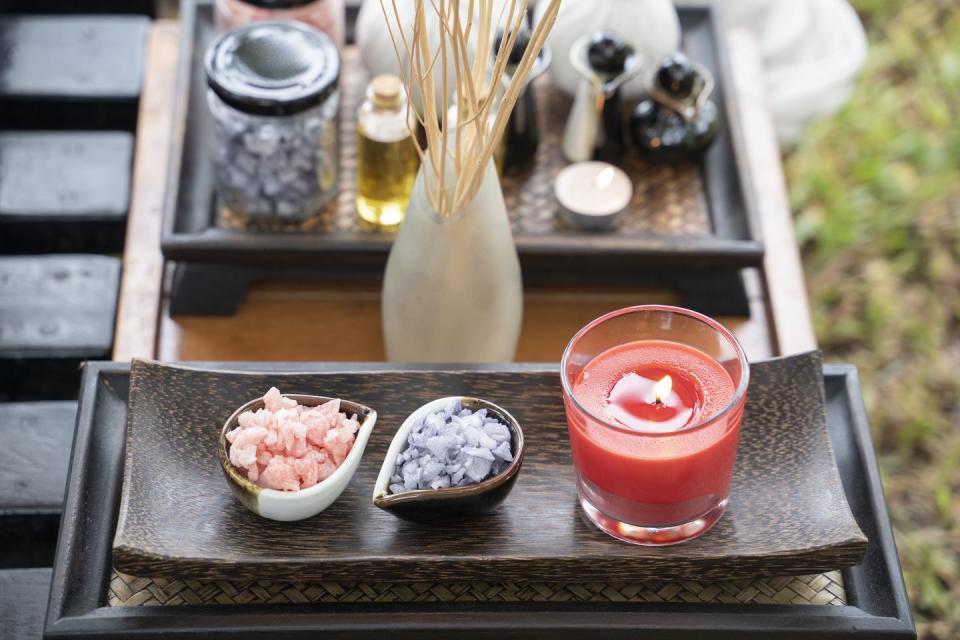What is reflexology and how does it work?

Reflexology is a type of manual therapy that involves applying pressure to the feet, ears, or hands. In recent years, this ancient Chinese practice has surged in popularity as a holistic therapy to relieve pain and stress.
Reflexologists believe that different areas – known as reflex points – correspond to specific organs of your body and bodily systems. For example, the liver is located in the arch of the foot. Applying pressure to specific reflex points is believed to stimulate your parasympathetic nervous system.
We speak to Nicola Hall, chairwoman of the representative body The British Reflexology Association, Michael O'Connell, a qualified reflexologist, and Matthew Rowe, lifestyle health adviser at Bupa UK, about the health benefits of reflexology:
What is reflexology?
Reflexology is based on the Chinese principle that certain areas on the soles of your feet or hands – containing millions of nerve endings – correspond to other parts of the body. All systems and organs of the whole body are said to be mirrored or reflected in smaller peripheral areas.
'Reflexology stimulates the body into healing itself by improving circulation, reducing stress, pain and restoring natural balance,' says O'Connell. 'A therapist may apply pressure to your big toe and ankle to calm your endocrine and reproductive system, helping to relieve PMS or menopausal symptoms.'
In Chinese medicine, practitioners use reflexology to balance qi – pronounced 'chee' – a philosophical concept that refers to energy. 'Around 3,000 years ago, Asian practitioners were massaging hands and feet applying pressure to certain points to stimulate organs, nerve endings and energy pathways to promote health,' says O'Connell.
This approach can be applied alongside conventional Western medicine to improve wellbeing and vitality. 'Though reflexology works on different principles to Western medicine, and there is little scientific evidence to back up its effectiveness, my clients say that their general health and wellbeing improves,' he adds.
How does reflexology differ from massage, Reiki, or acupuncture?
While massage, Reiki, and acupuncture all help to alleviate stress, they are very different types of therapies. Where reflexology is applied to specific points on your hands, feet and ears, massage is used on your whole body, says Rowe. The type of touch and pressure used is different, too. 'Reflexology therapists will mainly use their thumbs and fingers to gently massage the area, rather than larger hand and elbow movements used in a massage,' he says.
During Reiki – another type of complementary therapy – there is no physical manipulation or pressure whatsoever. Instead, a light touch is used to heal the body. Acupuncture in similar to reflexology in that it uses 'certain points across the body to help you relax', says Rowe, but 'focuses on the entire body, rather than a specific area.'
In reflexology and acupuncture, the body is divided into 12 pairs of energy zones, known as Meridians, explains O'Connell. 'Practitioners believe that when these energy channels become blocked a person feels unwell,' he says. 'They aim to dissolve any blockages causing ill-health by encouraging the free flow of vital energy through the body.'
What to expect during a reflexology session
So what does reflexology involve? On your initial consultation, your reflexologist may ask you about your medical history, health issues, lifestyle and diet, O'Connell explains. 'They will then apply painless pressure to your feet using their thumb and forefinger to identify which areas of your body aren't functioning properly.'
Sessions usually last 30 to 60 minutes and focus on the soles of your feet, 'unless you are very ticklish, in which case they can massage your hands,' O'Connell says. 'Some reflexologists use five or six sessions to treat specific health conditions and you do not have to undress.'
What can reflexology treat?
Reflexologists do not claim to diagnose or cure any ailments. While reflexology is linked to a huge variety of potential benefits, only a few of them have been observed in scientific studies. These include reduced stress, anxiety and pain, and improvements in mood and general health. This is because your nervous system – which controls almost every aspect of your health and wellbeing – can be influenced by outside factors, including touch.
Applying pressure to the hands and feet 'can help improve your blood supply, reduce any tension and bring balance to your body,' says Rowe. 'It can also provide good pain relief for those suffering with osteoarthritis, but make sure you consult your doctor before treatment. The theory behind reflexology is that it can help your body restore its balance naturally and can leave you feeling relaxed.'

Reflexology is also used to treat symptoms of the following:
Back pain
Migraine
Poor digestion
Irritable bowel syndrome (IBS)
Respiratory problems
Asthma
Headache
Bladder problems
Menopausal symptoms
Period pain
The National Institute for Health and Care Excellence states that reflexology may be helpful for multiple sclerosis (MS), but there is not enough evidence to give firm recommendations. 'Although little research has been done to prove that reflexology works to relieve the pain caused by MS, patients tell us that it does and often book further sessions,' says Hall.
Can reflexology help with anxiety?
There is some evidence that shows reflexology may help with anxiety, as it can leave you feeling relaxed and may lift your mood, says Rowe. A study published in the journal Complementary Therapies in Clinical Practice found that heart surgery patients who were given a 20-minute reflexology treatment once a day for four days reported significantly lower levels of anxiety than those who didn’t.
'When we're stressed or anxious, your adrenaline and stress hormone levels will increase, and this can leave you experiencing panic attacks, irritability and heart palpitations,' says Rowe. 'Through reflexology, it is thought that your body's systems are brought back to their normal level and may rebalance your adrenaline levels, which can ease symptoms of anxiety. It may also help you to sleep better – reflexology has been shown to increase sleep quality and duration for some.'
However, complementary therapies – like reflexology – work on an individual basis, so it can be difficult to know exactly how it benefits anxiety, Rowe adds. 'Plus, there is currently very little evidence or research to show that reflexology can treat any condition.' With that said, reflexology is safe, noninvasive and comfortable, so it may be worth trying if you suffer from anxiety.
What does it mean if reflexology hurts?
When congested reflex points are treated, they may be painful, tender or feel uncomfortable. Your reflexologist may spend extra time on these points during the session. Over time, the soreness should decrease with pressure. Your foot has 7,000 nerve endings, so when pressure is applied, it may hurt – but only temporarily.
'If you experience any pain, tightness or discomfort during a reflexology session, your therapist will apply pressure to reduce this, and to bring your body back into balance,' says Rowe. 'Reflexology shouldn't be a hugely painful experience, so let your therapist know if you're in a lot of discomfort.'
Does reflexology have any disadvantages?
Reflexology should not be used as an alternative to medical advice from your doctor. It's a type of complementary therapy, which means it should be used alongside – and not instead of – research-based medicine.
'Conventional medicine is based on research evidence, where treatments and medicines have been tested many times over to see whether and how well they work,' says Rowe. 'However, research about complementary therapies is mixed and less certain. More evidence is required to understand the benefits of therapies like reflexology.'
Reflexology works on an individual basis, like all complementary therapies, so you can't be fully certain it will work for you, Rowe adds. 'Before starting reflexology, let your doctor know – especially if you have an existing condition, such as diabetes (it may interfere with medication) epilepsy or circulatory problems,' he says.
Reflexology is not suitable for everyone, and shouldn't be used if you suffer from verrucas or athlete's foot, a recently broken or fractured bone in your ankle or foot, or broken skin.
Reflexology near me - how to find a reflexologist
Reflexology is not widely available on the NHS. It is offered at some cancer units in hospitals and often a contributory fee is required in such cases. As NHS access to this therapy is limited, most people pay privately. You can tell your GP that you are having reflexology and whether it helps, especially if you have an underlying condition.
Caution is advised when booking an appointment, as there are currently no regulations on who can call themselves a reflexologist. Make sure you ask where your therapist has trained. The British Reflexology Association was one of the first reflexology associations to be established and students receive at least one year's training.
Can you do reflexology on yourself?
It's always recommended that you see a trained, registered reflexologist, especially if you are pregnant or have an existing health condition. Your reflexologist will be able to give you a safe DIY massage to try at home. If you're keen to try reflexology, you should speak to your doctor first, says Rowe.
'If you've previously had reflexology and find that it works for you, a simple technique is to gently apply pressure to the top parts of your toes on the bottom side, and then move down to the base of your toes,' he says. 'Start massaging these points.'
Last updated: 11-01-2021
You Might Also Like

